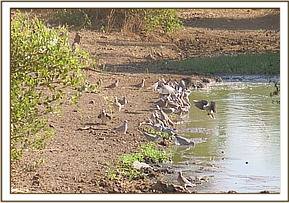Summary In October 2013 the Meru MVU responded to several instances of injuries to wildlife in northern Kenya
Summary
In October 2013 the Meru MVU responded to several instances of injuries to wildlife in northern Kenya. Injuries caused by gunshot in two elephants and a white rhino were treated. These animals are expected to make full recovery; however, fractures caused by gunshot have a poor prognosis due to inability to fix affected bones and the risk of infection.
An elephant in Namunyak conservancy with infected wounds caused by a poison laced spear was also treated. In Shaba national reserve a lion treated for wounds caused by an oryx attack is expected to make full recovery.
An investigation into an outbreak of a disease which had caused mass mortalities in wild birds in watering points in areas adjacent to the park was conducted to establish the species affected, distribution, period of the outbreak and to diagnose the disease.
Treatment of an injured elephant in Naibunga community conservancy
On 14th October 2013, Mpala conservancy reported that an elephant in Naibunga community was injured and required veterinary attention. The female elephant (25 – 30 years old) which had a 2 years old calf, showed lameness and swelling on the right forelimb.
She was immobilized for examination and treatment using Etorphine Hcl 16mg in a 1.5 cc DanInject dart. Darting was conducted on foot with the dart placed into the gluteal muscles at the right hind limb. Full effect was achieved in 5 minutes. The calf was kept nearby using a vehicle and later re united after the procedure.
Examination and treatment
Two infected penetrating wounds distal to the carpal joint of the left forelimb were observed. The wounds are thought to have been caused by gunshot. On probing with a forceps bone fragments were felt. Prognosis for recovery is guarded.
Treatment:
Wound lavage with hydrogen peroxide to remove the pus. Iodine applied into the wound 30% Oxytetracycline Hcl 200ml administered deep intramuscular Dexamethasone 50ml deep intramuscular
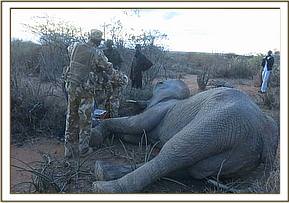


Treatment of an injured white rhino in Solio ranch
On 15th October, a female white rhino with a 2.5 year old calf was reported limping following an attempted poaching incident two days earlier.
We immobilized the animal for examination and treatment.
Chemical immobilization
A combination of Etorphine Hcl 5mg and Xylazine Hcl 60mg was used in a 1.5cc DanInject dart. Darting was conducted on foot with the dart placed into the left gluteal muscles.
After 8 minutes the animal went down on right lateral recumbency. The calf was then driven away using a vehicle.
On contact with the animal, copious amount of water was doused to cool the animal. Opticlox ointment was applied on the dart wound and eyes to prevent desiccation of the cornea. Vital parameters such as respiration were continuously monitored to ensure that the narcotized animal was stable.
After the procedure, Naltrexone ® 150mg and Atipamezole 10mg were administered intravenously into the superficial ear veins to reverse the effects of the opioid and the α-2 agonist. Diprenophine Hcl 24mg was also administered intramuscularly to prevent renarcotization.
Examination and treatment
Severe lameness on the left forelimb was observed. There was a penetrating wound into the lateral phalanx, with a larger wound distally on the hoof suggestive of bullet exit point. The hoof was detached half way caudally from the skin. On probing with a forceps bone fragments were felt. Prognosis for recovery is guarded due to the fracture and risk of infection.
Treatment:
Iodine lavage Betamox trihydrate LA 100mg injected deep intramuscular 5% Flunixin meglumine 50ml injected deep intramuscular
Repeat treatment may be necessary to monitor the progress of this animal.
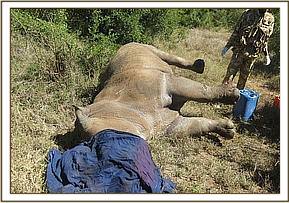

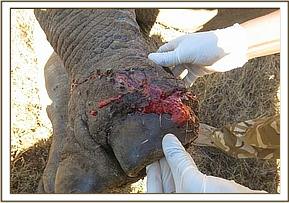
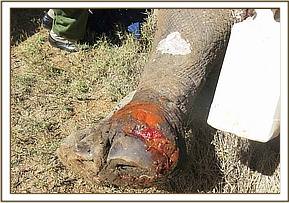
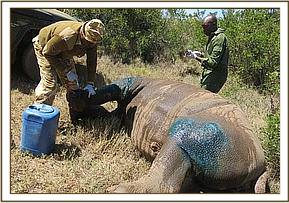

Wildlife scouts attached to the Milgis Trust reported a sick adult (>35 years old) male elephant in Sererit, at the foot of Ndoto mountains which required veterinary attention. The elephant had a wound which was discharging pus dorsally on its flank thought to have been caused by gunshot injury.
We immobilized the elephant on 17th October 2013 for examination and treatment. It was easy to locate the injured animal because of its limited movement.
Standard elephant immobilization procedure was followed. Immobilization was achieved on the third attempt using Etorphine Hcl 16mg in a 1.5cc DanInject dart. Because of rocky terrain darting was conducted on foot. Induction time was 12 minutes; the animal fell on the right lateral recumbency.
To reverse the anesthesia, Diprenophine Hcl 48mg was administered intravenously into the superficial ear veins.
Examination and treatment
There was an abscess in the dorsal muscles of the lumbar vertebrae which on probing with a forceps revealed a penetrating wound thought to have been caused by a bullet injury.
For treatment:
Thorough lavage with hydrogen peroxide and irrigation with iodine 30% Oxytetracycline Hcl 200ml administered deep intramuscular
This animal is expected to make a full recovery because the wounds involved soft tissue injury.
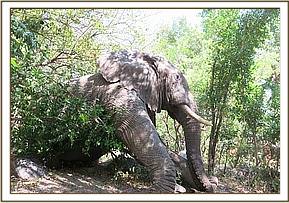

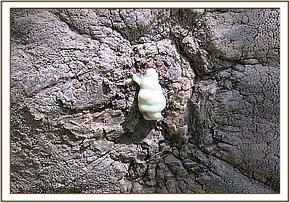

This was a male elephant reported, by the Namunyak community conservancy, to have a swollen front limb and lameness in Kibarte village. The bull was immobilized for treatment on 28th October after failed immobilization attempts 10 days earlier when the animal moved into a thick bush vegetation area.
The sick elephant was tracked by local wildlife scouts who followed his movements for 3 days to an open area in a lugga which was considered suitable for darting.
Chemical immobilization
Standard elephant immobilization procedure was followed. A combination of Etorphine Hcl 18mg with hyaluronidase 5000 i.u was used to achieve effective immobilization in the wooded riparian area. Darting was conducted on foot with the dart placed on the left gluteal muscles. The animal fell on sternal recumbency after 6 minutes. To reverse the anesthesia, Diprenophine Hcl 60mg was infused into the superficial ear veins.
Examination and treatment
The elephant showed lameness and a swollen right forelimb with a penetrating wound 5cm in diameter and 15cm deep caused by a sharp object into the muscles of the arm. There were two penetrating wounds with extensive necrotic tissue on the left thoracic area also deep caused by sharp object.
All these wounds had copious amount of pus. A bruise was also noted on the head. The wounds may have been caused by spears laced with a poisonous substance.
For treatment:
All wounds were thoroughly lavaged with hydrogen peroxide and irrigated with iodine Long acting 30% Oxytetracycline Hcl 200ml was administered deep intramuscular Dexamethasone 50ml intramuscularly
The elephant is expected to make a full recovery and the scouts were advised to closely monitor and report on its progress in case a second treatment is required.
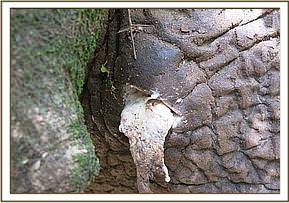

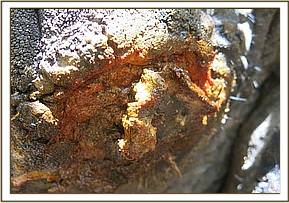

A 6 year old male lion was reported injured in Shaba national reserve by the Isiolo county game rangers on 22nd October. The animal was seen limping and showed little movements in the preceding two days and it was feared he was unable to hunt. He was immobilized for examination and treatment.
Chemical immobilization
To achieve immobilization a combination of 5% Ketamine Hcl 150mg and 4% Medetomidine Hcl12mg in a single 3cc DanInject dart was used. A second 3cc dart containing 5% Ketamine Hcl 150mg was added after 5 minutes from the initial dart. Both darts were placed into the gluteal muscles. Induction time was 10 minutes. The lion was then carried to a shade where it was placed on right lateral recumbency for examination.
The effects of Medetomidine Hcl were reversed after 90 minutes from the initial dart using Antisedan Hcl 30mg injected into the gluteal muscles.
Examination and treatment
Two penetrating wounds caused by a sharp object into the dorsal muscles of the left scapula were seen. On probing with a forceps bone fragments were felt. The skin around the wounds was swollen due to inflammation.
The wounds may have been caused by an attack by oryx during a failed attempt at hunting.
The wounds were washed thoroughly with water and savlon antiseptic and lavaged with iodine. Betamox trihydrate LA 20ml was injected intramuscularly 5% Flunixin meglumine 15ml intramuscularly for treatment of pain and inflammation
Two days later the lion was reported to be on its path to full recovery by a lion monitoring team from Ewaso Lions.

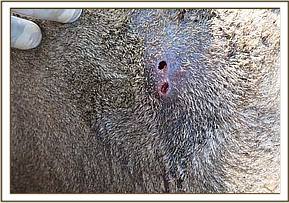

On 25th October, the senior warden at Meru national park during routine air patrol reported an emaciated lone elephant that was dragging its left forelimb. The adult female elephant had been reported 2 days earlier by tour guides in the area. Because of the dense woodland vegetation around the area which restricted observation we immobilized the animal for closer examination.
Standard elephant immobilization procedure was followed.
Examination revealed suspected internal injuries and limping was due to an old injury that had healed. No visible injuries were found externally. Long acting antimicrobial drugs and multivitamin injection were administered to cover bacterial infection.
Intense monitoring was advised due to poor prognosis of this case, however, efforts to trace the animal have not been successful so far.


Disease outbreak investigation in laughing doves
On 2nd October community living around Meru national park reported that birds were dying in large numbers in water holes around the park. We visited the concerned areas on a fact finding assignment to establish the species affected, distribution and period of the outbreak.
Interviews with local community revealed that the mortality first occurred in August 2013 affecting both domestic chickens and wild birds. The number of birds dying was reported to have reduced. Locals also reported the cyclical nature of the outbreak usually occurring in the dry season.
Areas affected include water holes in Bibi moriti, Kinna Meru and Kinna triangle. These are livestock watering points adjacent to the Eastern boundary of the park.
Mainly laughing doves and ring neck doves were affected out of all the wild bird species. Five fresh carcasses of dead/ sick birds were collected and post mortem examinations were performed on site, however, no conclusive findings were recorded.
Based on previous outbreaks of the disease in laughing doves in the area a tentative diagnosis of Newcastle disease caused by a paramyxovirus was made. Outbreaks of Newcastle disease are thought to be self limiting in affected species because of high mortalities.
This investigation was conducted toward the end of the outbreak. Further investigation by a veterinary research team later collected samples for laboratory diagnosis and results are awaited.
